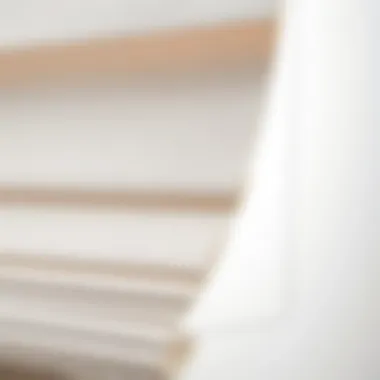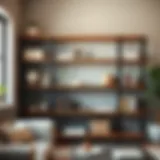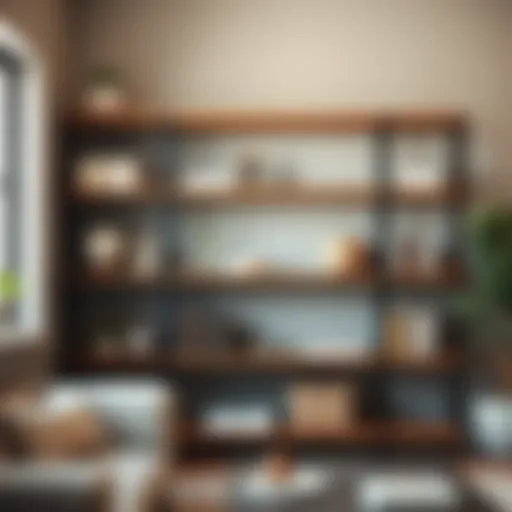Understanding Shade Sense Blinds: A Deep Dive


Intro
In today's world, where design and functionality walk hand in hand, shade sense blinds have emerged as not just window coverings but as essential elements that shape the living experience. With technology weaving its way into ordinary products, understanding how these blinds work, their designs, and the versatility they offer becomes crucial for homeowners and designers alike.
Shade sense blinds are more than just a means to block light. They serve a variety of purposes—from providing privacy to aiding in energy efficiency. Their application goes beyond residential settings, making them popular in commercial spaces and public areas as well. As we navigate through this article, we will explore the intricacies of these blinds, including their material science, the aesthetics they bring to a room, and practical tips for maintenance. Moreover, we’ll delve into the technological advancements that have transformed traditional blinds into sophisticated, smart systems that intuitively adjust to ambient light and temperature conditions.
Equipped with this knowledge, readers—from DIY enthusiasts to professional designers—will be better prepared to choose, maintain, and integrate shade sense blinds into their spaces, fostering an environment that embodies both comfort and contemporary style.
Preamble to Shade Sense Blinds
In today’s world, where maximizing living space potential is more vital than ever, shade sense blinds offer not just aesthetic appeal but also functional benefits that cater to modern needs. These innovative window treatments blend technology with design to provide solutions for energy efficiency, privacy, and optimal natural light management. As homeowners and designers strive for elegance and practicality, understanding the nuances of shade sense blinds becomes essential.
Defining Shade Sense Blinds
Shade sense blinds are a unique type of window covering that adjusts automatically based on the amount of light entering a room. This smart technology integrates sensors that allow the blinds to react to environmental changes. When the sun shines brightly, the blinds close to block excess light, reducing glare and heat. Conversely, they can open up to enhance natural lighting during cooler periods.
This duality helps strike a balance between comfort and energy savings, making these blinds an attractive choice for environmentally conscious consumers. Not only do they improve the atmosphere of a room, but they also significantly contribute to energy conservation. Homeowners seeking a versatile option for varying light conditions are increasingly turning to these solutions.
Historical Context and Evolution
The concept of window blinds isn’t new; people have been using them in various forms for centuries. Early iterations were made from materials like wood or cloth, offering basic functionality without the sophistication we see today. However, the emergence of technology has dramatically transformed these window treatments.
In the late 20th century, the introduction of motorized and automated systems began to revolutionize the industry. The evolution carried through the 2000s, leading to the development of more refined systems incorporating smart home features. The shade sense technology we have now exemplifies this trend, merging the art of design with the science of efficiency.
Modern shade sense blinds, combining smart functionality with various materials and styles, illustrate the progress we've made from basic blinds to highly sophisticated yet stylish solutions that align with contemporary lifestyles. As individuals seek to customize their homes according to personal tastes while maintaining functionality, these blinds emerge as a focal point in interior design.
Mechanics of Shade Sense Technology
Understanding the mechanics behind Shade Sense technology is essential for homeowners and designers alike. This section explores the innovative features and advantages that make these blinds stand out. By seamlessly integrating technology with design, Shade Sense blinds offer dynamic solutions tailored for various environments. Key benefits include user-friendly automation, enhanced energy efficiency, and versatile control over natural light. These features not only elevate aesthetics but also contribute to the overall functionality of a space.
How Shade Sense Works
To comprehend how Shade Sense blinds function, it’s important to look at the underlying technology. Essentially, these blinds are equipped with sensors that respond to light levels. When the environment brightens, the sensors activate to adjust the blinds automatically, allowing for optimal light management. This technology can be controlled through remote devices or home automation systems, providing users with convenient options for adjusting their blinds.
Imagine waking up and having the blinds gradually rise with the dawn. It creates not just a beautiful ambiance but also helps maintain your home’s internal temperature. This self-adjusting mechanism has profound implications for energy savings, leading to reduced heating and cooling costs.
"With Shade Sense technology, the blinds work as an extension of your home’s environmental control system. They adapt to your lifestyle effortlessly."
Interaction with Natural Light
Shade Sense blinds don’t just block light; they interact with it in a sophisticated manner. Depending on the time of day, these blinds can filter light to different degrees. In the morning, when the sun is low, they might allow more light to enter, creating a soft glow in living spaces. Conversely, during the afternoon, when sunlight can be too harsh, they can be adjusted to block out excess brightness.
This is particularly useful in urban settings where high-rise buildings might obstruct or reflect sunlight. The ability to fine-tune light exposure helps maintain a comfortable indoor climate. Additionally, these blinds can protect furniture and art from UV damage, preserving their colors and integrity over time.
Moreover, interaction with natural light can contribute to mental well-being. Natural light is known to affect mood and productivity; having control over it can create a more inviting and functional environment. This aspect doesn’t merely serve aesthetic needs, it enhances the quality of life within the home.
In summary, understanding the mechanics of Shade Sense technology reveals not only how these blinds operate but also the larger implications for energy efficiency, light management, and overall comfort in living spaces. These are not just blinds; they are an integral part of a modern, mindful home.


Design Varieties of Shade Sense Blinds
Understanding the design varieties of Shade Sense Blinds is crucial as it establishes how they integrate effectively into different styles of living spaces. Each type of blind offers distinct advantages, shapes the ambiance, and addresses specific needs of homeowners and designers alike. With a plethora of options available, one can carefully select what fits best with their preferences and functional requirements.
Material Options
Fabric Choices
Fabric choices play a pivotal role in the overall appeal and functionality of Shade Sense Blinds. The range of fabrics is vast, from light-filtering sheer materials to blackout options that provide complete privacy and light control. Fabrics such as linen or polyester are often favored for their durability, ease of maintenance, and ability to withstand UV rays.
One key characteristic of fabric blinds is their versatility in changing the mood of a room. For instance, a warm fabric in a cozy color can make a vast living area feel more intimate and welcoming. Furthermore, fabric blinds offer some unique features, such as energy efficiency. They can help regulate indoor temperatures, thus reducing energy bills during hot summers or cold winters. However, they might require more frequent cleaning compared to other materials.
Vinyl and Faux Wood
Vinyl and faux wood are gaining popularity due to their practicality and aesthetic qualities. Both options mimic the look of real wood but come without the hefty price tag or maintenance hassle. Vinyl, in particular, is water-resistant, making it a popular choice for kitchens and bathrooms.
These materials are often regarded for their durability. Vinyl blinds, for instance, resist warping and fading, which is a common issue with real wood. Faux wood blinds also offer a substantial level of insulation. The downside is that they may lack the organic texture of genuine wood. Yet, their affordability and ease of installation make them a go-to choice, especially for those on a budget.
Aluminum Variants
Aluminum variants bring a contemporary edge to interior decor. Their sleek and modern design appeals to those looking for minimalist aesthetics. One key characteristic of aluminum blinds is their lightweight nature, which makes them easy to operate and install.
Aluminum is also incredibly durable and resistant to rust, making it ideal for areas with high humidity, such as bathrooms or laundry rooms. A unique feature is their reflective surface, which can help redirect sunlight, contributing to energy efficiency. However, one must tread carefully as they can be prone to dents and scratches, so handling needs to be more cautious.
Styles and Aesthetic Appeal
Vertical vs. Horizontal Blinds
Choosing between vertical and horizontal blinds significantly impacts the visual space and light control. Vertical blinds are often used for larger windows or sliding doors. They can create an illusion of height and space, which is particularly beneficial in smaller rooms. Plus, their design makes them easier to clean.
On the other hand, horizontal blinds are more traditional and commonly used on smaller windows. They allow for finer adjustments in light control and privacy, which can be essential in bedrooms. The main disadvantage of vertical blinds is that they can be cumbersome to operate and may not always provide the best light coverage when closed. This might be a determining factor for some homeowners.
Custom Designs and Prints
Customization in designs and prints offers homeowners a chance to express their personality through window treatments. This unique aspect can significantly enhance a space, creating a focal point that attracts attention. Many manufacturers offer a range of patterns and textures, allowing for limitless creativity in decor styles.
The great thing about custom designs is the flexibility they offer in matching home decor styles, from rustic to ultramodern. However, custom options can come with higher costs, which is a consideration worth noting.
Practical Applications of Shade Sense Blinds
Shade sense blinds are more than just decorative accents in a home; they are powerful tools that offer a wide variety of practical benefits. They play a crucial role in enhancing energy efficiency, ensuring privacy, and promoting child safety. Understanding these applications is key for homeowners, designers, and anyone looking to make informed decisions when it comes to window treatments.
Energy Efficiency and Insulation Benefits
When it comes to energy conservation, shade sense blinds have a significant impact. By incorporating advanced materials and design, these blinds can effectively reduce energy consumption across different seasons. In summer, they block out excess sunlight, which helps keep indoor temperatures down. This can lead to a noticeable decrease in air conditioning costs. Conversely, during the winter months, the right blinds can act as an insulating barrier, preventing heat from escaping.
Here are a few aspects of how these blinds improve energy efficiency:


- Reflective Coatings: Many shade sense options come with reflective coatings that bounce back sunlight, minimizing heat absorption.
- Cellular Designs: These blinds often feature a honeycomb structure, which traps air and creates an insulating layer against outside temperatures.
- Custom Fit: Proper installation and fit ensure there are no gaps, making it harder for air to seep in or out.
By investing in these blinds, homeowners might not only enjoy a more comfortable living environment but also save significantly on energy bills over time.
Privacy Considerations
Privacy is oftentimes a top concern for homeowners, especially in urban areas where homes are closely packed together. Shade sense blinds excel in providing various levels of privacy without sacrificing natural light. Custom options allow individuals to tailor their choices based on their specific needs
Some important points to consider include:
- Translucent Options: Certain shades allow diffused light to flow while obscuring the view from outside, striking the right balance between illumination and discretion.
- Top-Down Bottom-Up Mechanism: This allows homeowners to lower the blinds from the top, providing privacy while letting in light from above.
- Layered Designs: A combination of sheer and blackout fabrics can be utilized, offering flexibility in regulating visibility and light levels.
Shade sense blinds offer valuable solutions that can reinforce a sense of sanctuary without darkening your space entirely.
Child Safety Features
In families where children are present, safety takes precedence above all else. Shade sense blinds incorporate smart designs that minimize the risk of accidents. Traditional blinds with cords may pose a strangulation hazard, making newer products that are cordless or equipped with advanced controls essential.
Key safety features include:
- Cordless Operation: Innovations have led to mechanisms that allow users to lift or lower blinds without cords, making them safer for children.
- Childproof Locks: Certain models come with locking features that prevent blinds from being manipulated by little hands, keeping them out of reach.
- Safe Design: Smooth edges and secure fittings ensure that even adventurous toddlers can’t easily dislodge or damage the blinds.
These thoughtful features not only align with safety standards but also promote peace of mind for parents and caregivers.
"Investing in shade sense blinds means to invest in comfort, privacy, and safety, which is paramount for every household!"
Installation and Maintenance
Installation and maintenance are cornerstone elements in ensuring that your shade sense blinds function optimally and continue enhancing your living space for years to come. Proper installation ensures the blinds fit securely and operate smoothly, while diligent maintenance keeps them looking their best and extends their lifespan. Homeowners investing in these innovative window treatments should consider these aspects carefully, as they contribute directly to the overall satisfaction with the product.
Installation Techniques
Installing shade sense blinds can seem daunting, but with the right technique, it can be straightforward. First and foremost, taking precise measurements of your window frame is essential. You wouldn't want to find yourself with a set of blinds that are too short or, on the flip side, too long. A commonly effective method is to measure the width and height of the window frame from multiple points to account for any discrepancies. Once you have your measurements, it’s time to select the appropriate mounting hardware which comes usually with the blinds. Follow the manufacturer’s instructions carefully, as each product might have its own quirks.
Using a level to ensure the brackets are straight is important. Uneven blinds not only look unprofessional but can also impede functionality. A cordless drill or screwdriver will simplify this task, allowing you to affix the brackets with ease. After brackets are in place, securing the blinds into the brackets requires a gentle but firm push.
As an additional tip, enlist a friend to hold the blinds while you secure them—this can save you from fumbling and potential mishaps.
Cleaning and Care Instructions
Keeping shade sense blinds clean is vital for ensuring they remain both aesthetically pleasing and functional. Over time, dust, dirt, and grime can accumulate, which might affect the performance and longevity of the blinds.
Routine Maintenance
Routine maintenance focuses on the simple, everyday actions that help maintain the appearance and performance of your blinds. A soft, dry cloth can work wonders for routine dusting. Regularly wiping them down prevents excessive build-up and is a popular choice among homeowners because it's quick and effective. An often-overlooked aspect of routine maintenance is using a vacuum with a brush attachment. This method reaches those awkward corners and can eliminate dust before it builds up too much.
The key characteristic of routine maintenance is its minimal effort for maximum benefit. By maintaining a schedule, perhaps once a month, you can ensure that your blinds remain in top condition, enhancing the overall aesthetic of your space without a hefty time investment.


Deep Cleaning Tips
Deep cleaning is where the nitty-gritty of care comes into play. This process is more thorough than routine maintenance and is necessary perhaps once or twice a year. For deep cleaning, starting with a mixture of mild soap and warm water can help remove stubborn stains. Applying the solution with a microfiber cloth and gently scrubbing will yield good results.
One unique feature about deep cleaning is the opportunity it provides to examine the blinds for any potential damage. Discovering a snag or broken slat can save you from further issues down the line.
However, be cautious with excess water or harsh chemicals as they may damage the materials. The advantages of deep cleaning outweigh the disadvantages when you consider the revived look and functionality of the blinds. A spotless window treatment not only elevates the look of the room but also reflects the care and attention you invest in your home.
Financing Shade Sense Blinds
When deciding to invest in shade sense blinds, financing becomes a significant consideration. Understanding how to fund this addition to your home not only impacts your budget but also affects the overall value of your living space. The cost of these blinds can vary widely, influenced by many factors including material, functionality, and brand. Each choice can mark a different impact on your financial health and satisfaction.
Cost Factors to Consider
Determining the price at the outset helps in planning your budget accordingly. Here is a breakdown of elements that can influence the cost of shade sense blinds:
- Material Quality: High-quality materials often come at a premium. For instance, faux wood blends quality aesthetics with affordability, while real wood options usually command higher prices due to their durability and visual appeal.
- Custom Designs: If you are looking for something unique, custom designs might be pricier. Off-the-shelf solutions often save money but may not offer the same flair or fit as custom ones.
- Technology Features: Advanced features such as smart automation or UV protection can add to the price. Investing in technology might appear daunting but can yield greater comfort and control.
- Size of Windows: Larger windows or specialized shapes often lead to higher costs as they require more materials and labor.
Considering these factors makes it clear that budgeting is key. It’s important to weigh each aspect against what you want out of your blinds.
Investment vs. Long Term Savings
Thinking about financing shade sense blinds shouldn't just be a matter of initial cost. It often requires a longer lens, looking at potential savings over time. Here are some points to consider:
- Energy Efficiency: Shade sense blinds can provide insulation, lowering heating and cooling costs. By creating a barrier against temperature fluctuations, they can conserve energy, leading to reduced utility bills.
- Durability and Longevity: High-quality blinds tend to last longer. Investing in a more durable product may mean that, while the upfront cost is higher, you won’t need to replace them often, translating to savings in the long run.
- Increased Property Value: Quality installations enhance the aesthetic appeal of your home, making it more attractive to potential buyers. If you ever decide to sell, this could be a valuable return on your investment.
- Health Benefits: By controlling light and UV exposure, these blinds can create a healthier indoor environment. This has the potential for fewer medical expenditures over time, particularly for those with conditions sensitive to sunlight.
"The best time to plant a tree was twenty years ago. The second-best time is now." Thinking of your blinds in terms of long-term benefits can lead to more informed decisions.
For further insights into home improvement and financing options, consider visiting Wikipedia's Home Improvement section or The Balance's Personal Finance guides.
Understanding these elements can guide homeowners, designers, retailers, and DIY enthusiasts alike in making informed choices that align financial constraints with aesthetic desires.
Epilogue
The topic of shade sense blinds is not just a trivial aspect of home decor; it encompasses a range of factors that significantly influence the living experience in modern homes. Understanding these blinds leads to informed decisions that resonate well with contemporary needs. As technology progresses, the connection between aesthetics, energy efficiency, and functional use becomes clearer. The marriage of all these aspects ensures that homeowners not only enhance the beauty of their interiors but also contribute positively to the environment by saving energy.
The Future of Shade Sense Blinds
Looking forward, the future of shade sense blinds appears promising. With the constant evolution of technology, we can expect further innovations that integrate smart features into these window treatments. Energy-efficient materials are becoming ever more popular, driven by the growing demand for sustainability. Imagine a set of blinds that not only adjusts automatically according to the time of day, but also tracks sunlight exposure and helps reduce heating and cooling costs.
Furthermore, advancements in smart home integration may lead to features that allow homeowners to control their blinds from their mobile devices or through voice commands. Beyond just function, we may witness a surge in customizable designs. Homeowners are already reveling in the idea of bespoke prints that reflect personal taste while still maintaining utility. This blend of individuality with practicality showcases the bridging of technology with design.
In summary, the future is about enhancing comfort and convenience while prioritizing sustainability, aligning with the ethos of modern living.
Final Thoughts on Selection and Usage
When selecting shade sense blinds, consider factors beyond just color and style. Think about their placement within the space and how their functionality aligns with your lifestyle. Whatever your priorities—be it energy savings, privacy, or aesthetics—ensure those elements are front and center during your selection process.
Using these blinds involves more than pulling strings or pressing buttons. For optimal usage, routine maintenance and understanding the technology behind them is crucial. This ensures longevity and continuous performance that aligns with your expectations.
Engagement with these features can enhance your overall home environment. Therefore, familiarize yourself with their operation, and don’t hesitate to explore all that shade sense blinds offer. They are not just a window covering; they are an investment into a more efficient, stylish, and comfortable living space.
"Investing in quality shades not only elevates the decor but also transforms how we interact with our living spaces."







